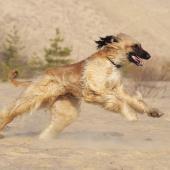Requirements
- The dog’s chip number is checked and verified in connection with the examination
- The person performing the examination has been approved by the FInnish Kennel Club to do so
- The dog is the required minimum age at the time of examination
Official health examinations
More than 70,000 official health examinations organised by the Finnish Kennel Club and stored in the open breeding database are carried out in Finland every year. For many breeds, official examinations may be a requirement for using the dog for breeding purposes. In Finland, eye and hip examinations are the most common.
Hip and elbow screening
Hip dysplasia (HD) is the most common malformation of the skeletal system and joints in dogs. Elbow dysplasia (ED) is the most common reason for front limb joint pains and lameness in large and giant dog breeds. Hereditary canine hip and elbow dysplasia is examined using X-rays. Statements will be given on hip dysplasia in accordance with the FCI instructions. For elbow dysplasia, IEWG recommendations and scales are utilised.
Spine
A spine statement is given based on X-rays, and depending on the dog’s age and breed, it includes a statement on spondylosis deformans, intervertebral disc disease (chondrodystrophic breeds), vertebral malformations (breeds with corkscrew tails) and lumbosacral transitional vertebra. The statement on spondylosis deformans and intervertebral disc disease on chondrodystrophic breeds may be given once the dog is 24 months old. For birth defects, or the statements on vertebral malformations and lumbosacral transitional vertebra may be given once the dog is 12 months old.
Patellar luxation
Structural weaknesses of the patella expose to patellar luxation or the dislocation of the patella. Toy dogs experience patellar luxation relatively often, as do larger breeds with a straight back limb. Patellar luxation can be examined in clinical examinations. The official examination result is defined according to the worse knee.
Eye examinations
Different hereditary eye diseases or eye diseases that are presumed to be hereditary have been discovered in more than 160 dog breeds. The relevance of the disease on the dog’s quality of life and visibility ranges from less to blinding and/to painful or an issue otherwise severely impeding the dog’s well-being. Canine hereditary eye diseases are examined and prevented by using eye examinations of which a statement is recorded on the ECVO form. The statement covers all changes in the eye and the surrounding structures. Eye examinations are also examined using DNA tests.
DNA testing
Canine hereditary characteristics, diseases and defects may be examined and prevented using genetic testing. DNA results are stored for all breeds with accepted genetic test in the Finnish Kennel Club. For some breeds, results from a DNA test is a prerequisite for registration. Currently, the genetic test results that are recorded apply to the T-box mutation, different eye diseases and the Shar Pei autoinflammatory disease.
Cardiac examinations
The purpose of cardiac examinations is to chart canine cardiac diseases and support their prevention. A cardiac examination approved by the Finnish Kennel Club may be conducted on a dog of any breed but, for certain breeds, the examination or a part of it may be a requirement for using the dog in breeding. The cardiac examination includes an auscultation examination, or listening to the heart and/or ultrasound examination that includes an auscultation and ECG examinations in addition to the cardiac ultrasound examination. All dogs entering the cardiac examination always also go through a clinical examination in which special attention is paid to possible changes caused by possible cardiac insufficiency.
BAER (Brainstem Auditory Evoked Response) Test
Many dog breeds, such as Dalmatians and Bull Terriers, experience congenital deafness. Hereditary deafness in dogs is examined using the brainstem auditory evoked response test, or BAER test. The testing helps identify animals with one or two deaf ears. BAER test results have been published in the Finnish Kennel Club’s breeding database since September 2017.
Syringomyelia
Canine hereditary Chiari malformation/syringomyelia is examined using magnetic resonance imaging. The Chiari-type malformation (CM) refers to relative tightness in the hollow place in the dog’s scull. As a result, the cerebellum and often also the brainstem are pushed backwards to the foramen magnum or through it.
Syringomyelia (SM) refers to the creation of fluid-filled cavities in the spinal cord as a result of the abnormal movement of the cerebrospinal fluid. The most important exposing factor to syringomyelia is a Chiari malformation. In Finland, the most examined breed is the Cavalier.
BOAS test
The BOAS test is meant for short-muzzled (brachycephalic) breeds that have symptoms caused by upper respiratory tract disorders. These breeds include Pug, English Bulldog and French Bulldog. The dog's exercise tolerance and the ability to breathe normally are evaluated in the exercise tolerance test and the clinical examination included. In the test, the dog must walk a certain distance in a defined maximum time and recover from the exercise within a defined time frame.
Liver statements
Liver statements are recorded for two breeds, Bedlington Terriers and Dobermans. Bedlington Terriers are examined for hereditary copper storage hepatopathy using a direct genetic test, a DNA marker examination or a liver biopsy. Dobermans are examined for chronic active hepatitis (CAH). The statement is provided based on a blood sample taken by a veterinarian in a VETLAB or a Movet laboratory.







 Hau-Hau Champion
Hau-Hau Champion Agria
Agria